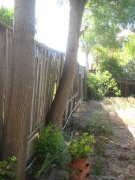We've got some very old redwood fencing that's finally being replaced, but two fairly large, roughly 20 year old European Ash trees (either Narrow-Leaf Ash Fraxinus angustifolia or Fraxinus excelsior, though they look very much like the latter otherwise, and the buds are darker brown than I can find pictures for the former, but not 'jet black' as F.excelsior is supposed to be, more of a dark chocolate brown) and wanted to know if it's worth saving the butt logs and possibly crotch wood for carpentry and turning.
Given they came up against fencing, they're not perfectly straight, but I wasn't sure where the line was between marginal use (or firewood) or something worth saving. They're too small to be of much interest to any larger scale mill, but some small scale or DIY shop might be interested. (that and if the trunk is too curved for practical board or stave use, it might have interesting figure for turning)
Along the same fence, there's a pair of quite tall (around 20 feet) Mexican Orange Blossom Trees (we've been calling them mock orange, but they appear to be Choisya ternata) that aren't endangering the fencing, but we're also leaning towards taking down. Mom is on the fence (no pun intended) over trying to keep those, but they'd need heavy pruning at the very least and I'm not sure they'd respond well to being topped or anything of that sort. (I know most trees don't and it's generally a bad practice, and was also just considering leaving the stumps and seeing if root stock came up enough to make shrubs out of, that or possibly leaving several feet of trunk and some of the lower branches and letting it leaf out again from there)
There was some controversy over fire danger of those orange blossom trees being fire hazards, otherwise I'd consider simply thinning them out, pruning them away from the roof, and leaving them at their current height.
It'd be an obscure thing to use for woodworking, but if anyone thinks there's interest in some long sections of Mexican Orange, I'll keep that in mind too. (I'm not sure of the structural properties, but it might make some interesting walking sticks or some sort of turning, or maybe carvings)
Removal of the old fence starts on Thursday (June 7) and I believe the tree removal follows that, so I've kind of waited to the last minute for advice here, but any input would be helpful.
On a side-note, there's also some old-growth 4x4 redwood posts and boards in that old fencing (something we failed to take note of when the main portion was removed some years back, sadly) and I'm hoping to scavenge some of that, too. (there's one large section of 2x12 retaining wall that's probably no good where it's in contact with soil, but around 6 feet of it that's just open air on both sides and seems solid ... our fence contractor said it was just trash, but I'm skeptical there)
Given they came up against fencing, they're not perfectly straight, but I wasn't sure where the line was between marginal use (or firewood) or something worth saving. They're too small to be of much interest to any larger scale mill, but some small scale or DIY shop might be interested. (that and if the trunk is too curved for practical board or stave use, it might have interesting figure for turning)
Along the same fence, there's a pair of quite tall (around 20 feet) Mexican Orange Blossom Trees (we've been calling them mock orange, but they appear to be Choisya ternata) that aren't endangering the fencing, but we're also leaning towards taking down. Mom is on the fence (no pun intended) over trying to keep those, but they'd need heavy pruning at the very least and I'm not sure they'd respond well to being topped or anything of that sort. (I know most trees don't and it's generally a bad practice, and was also just considering leaving the stumps and seeing if root stock came up enough to make shrubs out of, that or possibly leaving several feet of trunk and some of the lower branches and letting it leaf out again from there)
There was some controversy over fire danger of those orange blossom trees being fire hazards, otherwise I'd consider simply thinning them out, pruning them away from the roof, and leaving them at their current height.
It'd be an obscure thing to use for woodworking, but if anyone thinks there's interest in some long sections of Mexican Orange, I'll keep that in mind too. (I'm not sure of the structural properties, but it might make some interesting walking sticks or some sort of turning, or maybe carvings)
Removal of the old fence starts on Thursday (June 7) and I believe the tree removal follows that, so I've kind of waited to the last minute for advice here, but any input would be helpful.
On a side-note, there's also some old-growth 4x4 redwood posts and boards in that old fencing (something we failed to take note of when the main portion was removed some years back, sadly) and I'm hoping to scavenge some of that, too. (there's one large section of 2x12 retaining wall that's probably no good where it's in contact with soil, but around 6 feet of it that's just open air on both sides and seems solid ... our fence contractor said it was just trash, but I'm skeptical there)









